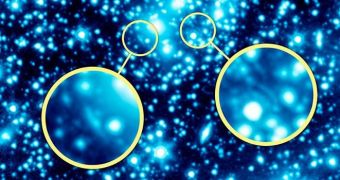Officials at NASA announced recently that all three of the agency's remaining Great Observatories have embarked on an ambitious project called Frontier Fields, which seeks to image the earliest galaxies that developed in the Universe. The effort includes the Hubble Space Telescope, the Chandra X-ray Observatory and the Spitzer Space Telescope.
Until 2000, NASA had four Great Observatories, including the Compton Gamma Ray Observatory (CGRO). The spacecraft was launched into orbit by space shuttle Atlantis during flight STS-37, in 1991, and observed the Universe in gamma rays. Following a gyroscope failure, the telescope was deorbited 14 years ago.
Together, these four telescopes covered most of the electromagnetic spectrum, from gamma rays, through X-rays and visible light, all the way to infrared. Now deprived of gamma ray capabilities, the remaining Great Observatories will join forces to look for the earliest galaxies in the Universe, something that is impossible to do with just one of these assets.
Frontier Fields will be heavily focused on using gravitational lenses to see these distant and faint objects. Gravitational lenses are basically large clusters of galaxies or stars that have such high mass they distort the light passing through and around them. They basically amplify the light coming from objects located far away behind them.
“Our overall science goal with the Frontier Fields is to understand how the first galaxies in the universe assembled. This pursuit is made possible by how massive galaxy clusters warp space around them, kind of like when you look through the bottom of a wine glass,” says astronomer Peter Capak.
The expert holds an appointment as a research scientist with the Spitzer Science Center at the California Institute of Technology's (Caltech) Jet Propulsion Laboratory (JPL), and is also the lead scientist for Spitzer's involvement in Frontier Fields. He explains that this project will take the use of gravitational lensing to a whole new level.
Only the most distant and massive clusters known to date will be used as lenses for this study. The goal is to see galaxies that are located even farther away, if such objects indeed exist. These clusters will therefore provide the highest degree of magnification possible.
Another component of Frontier Fields will be the accurate evaluation of the galactic clusters, so that astronomers can gain a deeper understanding of how these structures distort and amplify light coming from behind them. In turn, these data will help experts better determine the distance between Earth and the earliest galaxies in the Universe.
“This program exemplifies the combined strength of NASA's Great Observatories when it comes to digging deep into the distant Universe,” comments expert Jennifer Lotz, who is based at the Space Telescope Science Institute (STScI). The organization manages the Hubble telescope for NASA.

 14 DAY TRIAL //
14 DAY TRIAL //